The day long conference brings together professionals who are prime audience for VIGILAIR Systems, Inc. Attendees tend to be progressive and active men and women who manage the physical plants of regional hospitals. Among the participants were several current customers who have VIGILAIR® installed inside their facilities.
The conference’s first speaker provided an update on the ‘Environment of Care.’ Michael Rudolf explained changes in JACHO programs, how to prepare for a survey and how to respond should you face a ‘Recommendation For Improvement’. Mike proved to be one of the most thoroughly prepared and well researched presenters I’ve heard in a long time. He is the Director of Improvement Services for VHA East Coast.
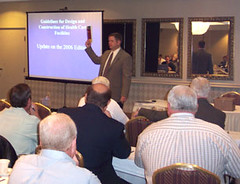 The Director of KTH Architects provided compelling information on AIA’s new Guidelines for Design and Construction of Health Care Facilities. John Adams not only knows what the changes are, he also knows why they changed them and how the guideline authors arrive at decisions. I had a chance to talk to John about one of those changes, the move to design all new patients rooms as single bed. According to John there are several reasons for this change:
The Director of KTH Architects provided compelling information on AIA’s new Guidelines for Design and Construction of Health Care Facilities. John Adams not only knows what the changes are, he also knows why they changed them and how the guideline authors arrive at decisions. I had a chance to talk to John about one of those changes, the move to design all new patients rooms as single bed. According to John there are several reasons for this change:- reduce nosocomial infections
- patient comfort
- HIPPA/privacy concerns
It is encouraging to see guidelines that recognize the relationship between Hospital Acquired Infections (HAI) and a hospital’s design. As John explained, decisions are based upon scientific literature. It in incumbent upon entities such as VIGILAIR® to provide the AIA with the growing body of evidence that links air quality and infection transmission. The AIA wants to make timely recommendations and is strongly considering instituting periodic findings to address emerging problems. Wholesale guideline reviews will continue on a four year cycle.

PSHFE President Jim Kelley presented several awards to delegates and reviewed the group’s improving fiscal health.
So you arrive at the hospital that you work at one day. Patients are lined-up out the ED’s door. 70 of them need ventilators. You have ten. You need extra staff, but 1/3 of your workers cannot or will not report to work. What do you do?
 That was the question poised by Melissa Speck, the Director of Policy Development at the Hospital & Healthsystem Association of Pennsylvania (HAP). Ms. Speck focused on the issues hospitals face should a pandemic strike. Then she broadened to topic to include any emergency incident that causes the need for surge capacity. Ms. Speck was careful to stress preparation, rather than panic in such situations. She urged delegates to become involved in planning and warned them not to expect the Federal government to come to the rescue. Following her presentation, she spoke to my colleague and me at our display booth. Ms. Speck seemed particularly interested in the fact that several of our Pennsylvania VIGILAIR® installations were funded by HERSA grants.
That was the question poised by Melissa Speck, the Director of Policy Development at the Hospital & Healthsystem Association of Pennsylvania (HAP). Ms. Speck focused on the issues hospitals face should a pandemic strike. Then she broadened to topic to include any emergency incident that causes the need for surge capacity. Ms. Speck was careful to stress preparation, rather than panic in such situations. She urged delegates to become involved in planning and warned them not to expect the Federal government to come to the rescue. Following her presentation, she spoke to my colleague and me at our display booth. Ms. Speck seemed particularly interested in the fact that several of our Pennsylvania VIGILAIR® installations were funded by HERSA grants.A quick recognition of the other vendors who were working hard:
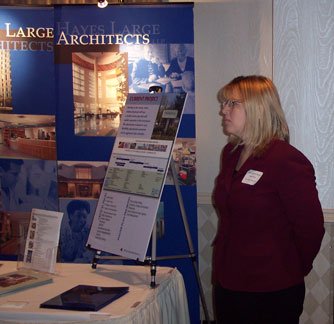 |  |

Jennifer who teamed-up with John Adams to represent KTH Architects.
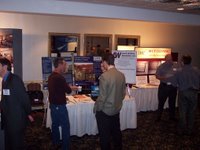
The always outgoing Leslie (sadly, mostly hidden in this shot) and her colleague James kept things interesting throughout the conference.
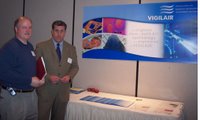
Here's Tom Leach (VIGLAIR System's NYC Sale Representative) at our booth chatting with Tim Robb.
This conference featured excellent speakers and interesting people. I'm certain that next year's conference will be even better!
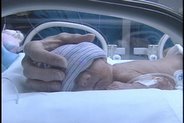

No comments:
Post a Comment